2023 Average Engagement Rates for 13 Industries [STATS]

Get up-to-date social media benchmarks for key industries and understand how your results stack up right now.


Get up-to-date social media benchmarks for key industries and understand how your results stack up right now.
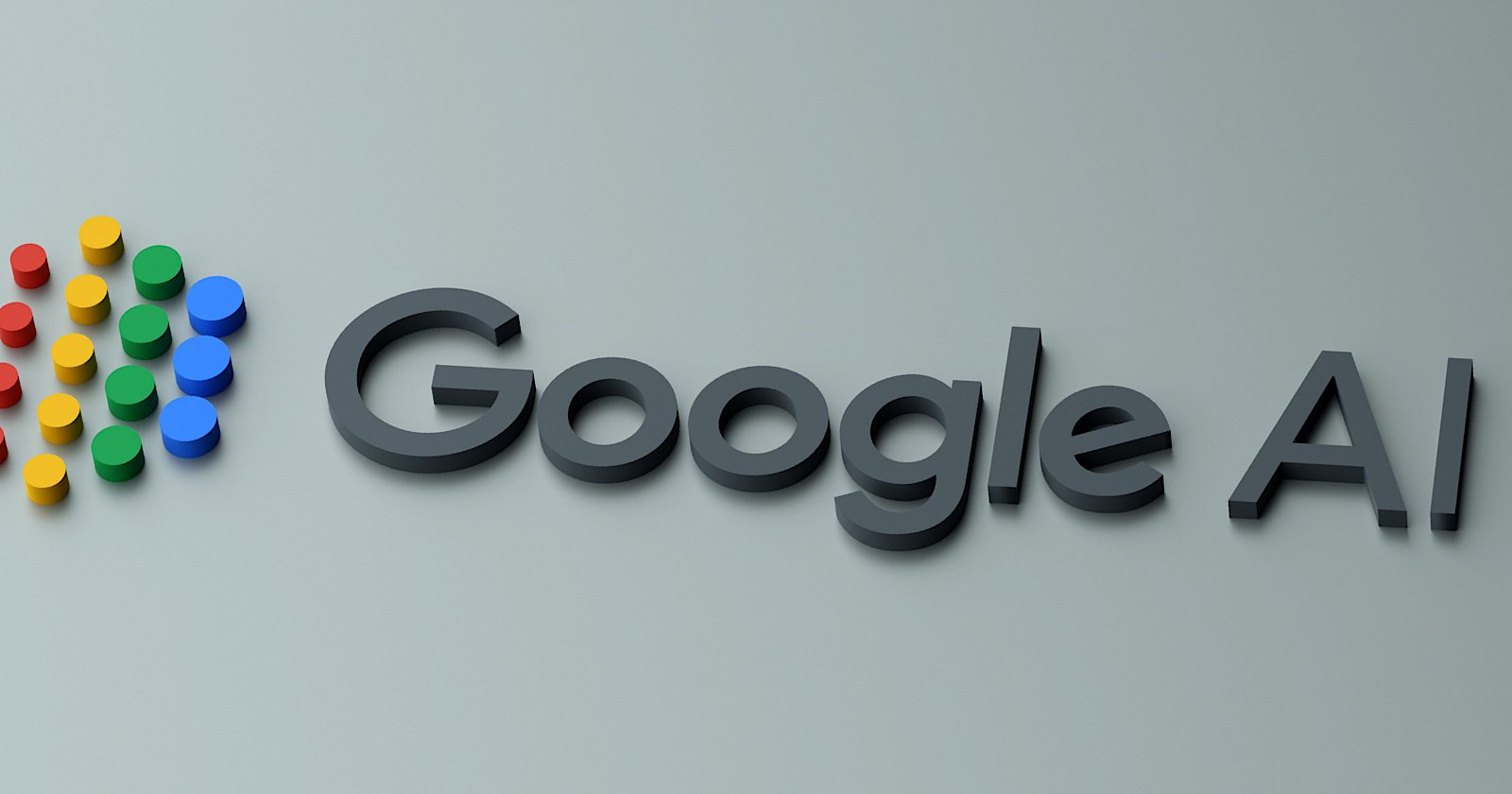



Google has introduced a range of training resources centered on generative AI.
Two comprehensive learning paths are now available on Google Cloud Skills Boost.
An “Introduction to Generative AI” path contains introductory, non-technical courses suited for sales, marketing, HR, and operations roles.
The “Generative AI for Developers” path includes technical hands-on labs and courses designed for software developers and engineers.
Each learning path provides a mix of theory and practical experience, including video courses, hands-on labs, and opportunities to earn skill badges.
Google says the training materials will be continually updated, ensuring they keep pace with the latest developments in the field.
Google’s Introduction to Generative AI course is offered for free and only takes 45 minutes to complete
The non-technical introductory path contains courses on responsible AI principles and how generative AI can impact business.
Continue the free learning path to get the Generative AI Fundamentals skill badge. It consists of the course mentioned above and two other courses: ‘Introduction to Large Language Models’ and ‘Introduction to Responsible AI.’
Completing everything takes around two hours in total. Once finished, you’ll receive a digital skill badge to display on your resume and social media to showcase your foundational knowledge of Google Cloud’s generative AI technology.
The “Generative AI for Developers” course is built for app developers, machine learning engineers, and data scientists.
To take the advanced path, you must first complete prerequisite courses “Introduction to Responsible AI” and “Generative AI Fundamentals.”
Be advised that the advanced path is not free. Google Cloud credits are required for the more advanced technical labs on services like Generative AI Studio and Vertex AI.
A Google Cloud Innovators Plus subscription grants access to all generative AI content and a full year of on-demand training through the Google Cloud Skills Boost program.
Google Cloud offers a range of generative AI labs, allowing learners to gain practical experience by working directly on the platform.
Here’s a list of available labs and amount of Google Cloud credits required to participate:
Google Cloud has collaborated with DeepLearning.AI, led by AI expert Andrew Ng, for a new course titled “Understanding and Applying Text Embeddings with Vertex AI.”
This free course offers insights into classification, outlier detection, text clustering, and semantic search.
Those looking to skill up in generative AI can get started immediately through Google Cloud’s Skills Boost platform.
The introductory path overviews responsible AI principles and generative AI applications, while the advanced path offers technical hands-on labs for developers.
Expect Google to expand its training catalog to keep pace with this evolving field.
Featured Image: Shaheerrr/Shutterstock
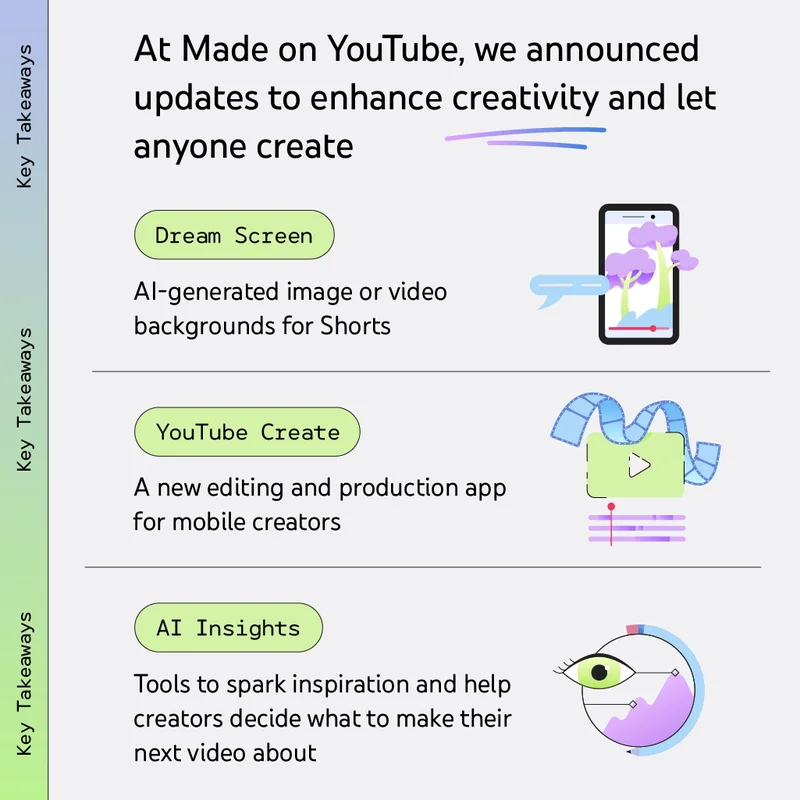
Late last week, YouTube unveiled a suite of AI-powered tools for video creators at an annual event that is aptly named “Made On YouTube.”
The announcements include:
Even though creators can’t get their hands on some of these new apps and features for months, YouTube has laid out a product roadmap that shows how AI can help them “to push the bounds of creative expression…by making the difficult things simple, and the impossible dreams possible,” said Toni Reid, YouTube’s Vice President of Emerging Experiences and Community Products.
This product roadmap should also help YouTube to fend off competitors like TikTok and Instagram in the ongoing battle for creative talent, which is the key to attracting, engaging, and retaining billions of monthly active users worldwide.
YouTube also updated everyone from creators to advertisers to the press that its lead in viewers is now deeper and wider by announcing that YouTube Shorts is now averaging more than 70 billion daily views from over 2 billion signed-in users every month.
And apparently, the leading social video platform didn’t think that it was necessary to remind attendees of this year’s Made On YouTube event what Amjad Hanif, YouTube’s Vice President of Creator Products, had said at last year’s Made On YouTube event:
“Over the past three years, we’ve paid creators, artists and media companies over $50 billion.”
So, if you were a creative entrepreneur – even one with a presence on multiple social video platforms – which one would you focus on to build a successful business of your own with employees and full-fledged operations?
Who knows – the latest announcements at Made On YouTube may tip the balance in that calculation.






So, let’s take a closer look at YouTube’s suite of new products and features – not in the order in which they were presented nor in the order in which they will become available, but in the order in which creative entrepreneurs will use them to make videos worth watching and create content worth sharing.
According to Reid, “AI can give creators more efficient tools to help them come up with new ideas and reach new audiences.”
This is the premise behind a trio of AI-powered tools:
At this year’s Made On YouTube, Reid also announced Dream Screen, a new experimental feature that enables creators to make AI-generated video or image backgrounds for their Shorts “simply by typing an idea into a prompt.”
He added,
“Ever wish you were filming in outer space? Trekking through an enchanted forest? Dreamt that your pug drove you to school?
With Dream Screen, creators will be able to generate new, fantastic settings for their Shorts that are only limited by what they can imagine.”
YouTube will begin testing Dream Screen later this year with select creators before rolling out the feature more broadly next year.
Finally, Reid said,
“We know the production process for videos can be difficult and often prevents that first-time creator from uploading their first video.
To streamline this process and allow anyone to create and share videos right to YouTube, we’re launching a new mobile app called YouTube Create.”
The app is designed to make video production for Shorts or longer videos simpler and easier, so creators can spend more time and energy making videos worth watching and creating content worth sharing.
YouTube Create offers a variety of video editing tools, including precision editing and trimming, automatic captioning, and voiceover capabilities.
The app also provides access to a library of filters, effects, transitions, and royalty-free music “with beat matching technology.”
This should enable creators to produce their next YouTube video without relying on complex video editing software. And they should be able to do all this with their mobile phones.
YouTube Create is currently in beta on Android in select markets and will be free of charge.
Reid added,
“Creators have been an incredible source of insight and feedback as we built this early version of YouTube Create, and we’ll continue to work with the creator community as we add new features and capabilities over time.”
So, will YouTube’s product roadmap enable creators of diverse backgrounds and levels of experience to “push the boundaries of creator innovation,” as the YouTube team put it on the video platform’s official blog?
The honest answer is: we’ll have to wait and see.
But here are some benchmarks to help us measure the company’s progress: According to Tubular Labs data, 759 million videos were uploaded to YouTube by 24.6 million accounts in the last 365 days.
And these videos got a total of 23.6 trillion (with a “t”) views and 745 billion (with a “b”) engagements (e.g., likes, comments, and shares).
But, based on my experience and expertise, I’d bet dollars to doughnuts that all these benchmarks will be eclipsed a year from now.
Why am I so confident?
I’m betting that YouTube developers haven’t lost their remarkable skills and competencies.
And YouTube is now doing a significantly better job of marketing its new AI-powered tools than it has done with previous products and features.
For example, I was surprised to see that the YouTube for Press section of its official blog had been updated with the latest announcements.
In the past, similar announcements were often buried in the YouTube Help Center.
Plus, YouTube went beyond sharing Reid’s comments in a post on its official blog. Late last week, the video platform also uploaded photos and recaps from the Made On YouTube event, including “Made on YouTube Recap.”
So, the competition from TikTok and Instagram seems to have prompted YouTube to up its game in marketing and product development.
And that’s good news for creators, as well as advertisers who want to reach potential customers where they’re watching videos and consuming content.
Disclaimer: All statistics not linked are from a gated Tubular Labs report.
More resources:
Featured Image: issaro prakalung/Shutterstock
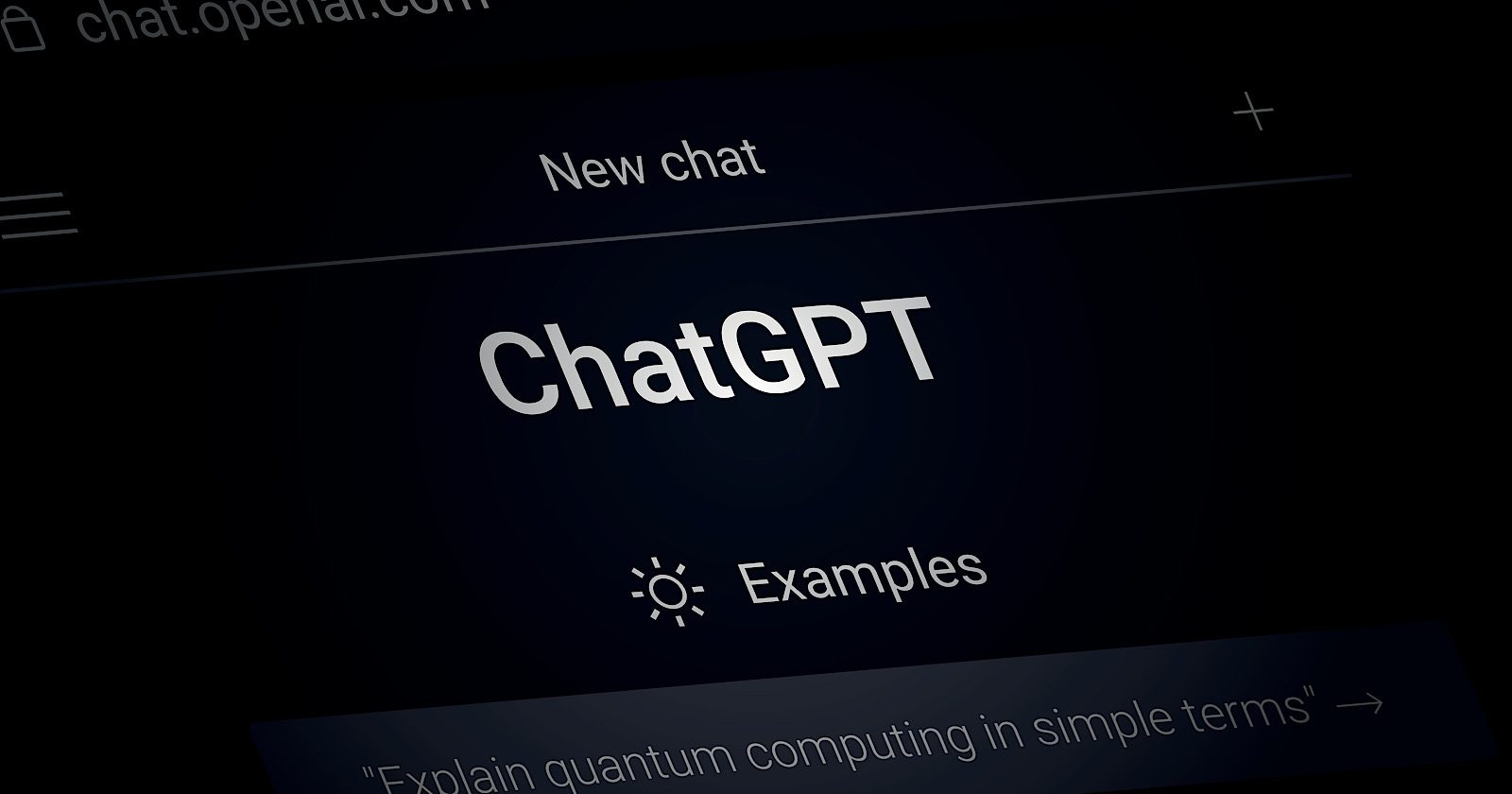



OpenAI has begun rolling out new voice and image features for its popular AI-powered chatbot, ChatGPT.
These new capabilities allow you to have more natural conversations with ChatGPT by speaking to it and showing it images.
This enables more ways to utilize ChatGPT in daily routines. For example, while traveling, you can send ChatGPT a photo of a landmark and engage in a real-time conversation about it.
Similarly, at home, you can take pictures of your refrigerator’s contents and discuss meal ideas or request a step-by-step recipe.
Over the coming weeks, OpenAI will roll out these features to Plus and Enterprise users. The voice capability will be available on mobile apps, while the image functionality will be accessible across all platforms.
The new voice feature allows you to speak conversationally with ChatGPT, which can now respond audibly in one of five synthesized voices.
You can opt-in through iOS and Android mobile app settings to enable voice.
According to OpenAI, the voice capability uses an advanced text-to-speech model trained on samples from voice actors. For speech recognition, it leverages Whisper, OpenAI’s open-source speech system.
You can now show ChatGPT one or more images to provide visual context and focus the conversation.
For example, sharing a photo of a broken appliance could help ChatGPT diagnose issues and suggest fixes. On mobile, a drawing tool allows circling or pointing out specific parts of an image.
The image features use a multimodal version of the GPT-3.5 and GPT-4 models fine-tuned to reason about visual inputs. OpenAI tested the image capabilities extensively for safety risks before rolling out.
OpenAI noted it’s taking a gradual approach to deploying these features.
The new voice technology opens up creative applications but also risks like the impersonation of public figures. To mitigate risks, voice is currently limited to conversational chat.
For images, OpenAI said it has limited ChatGPT’s ability to directly analyze people in photos and advise against high-risk use cases without verification.
ChatGPT’s new voice and image capabilities offer users a more natural way to interact with the AI system.
However, OpenAI is taking a measured approach to roll them out, limiting initial access and functionality due to potential risks.
As these features expand, keep in mind ChatGPT’s limitations and avoid high-risk applications without verification.
Featured Image: Ahmed_Rizq/Shutterstock
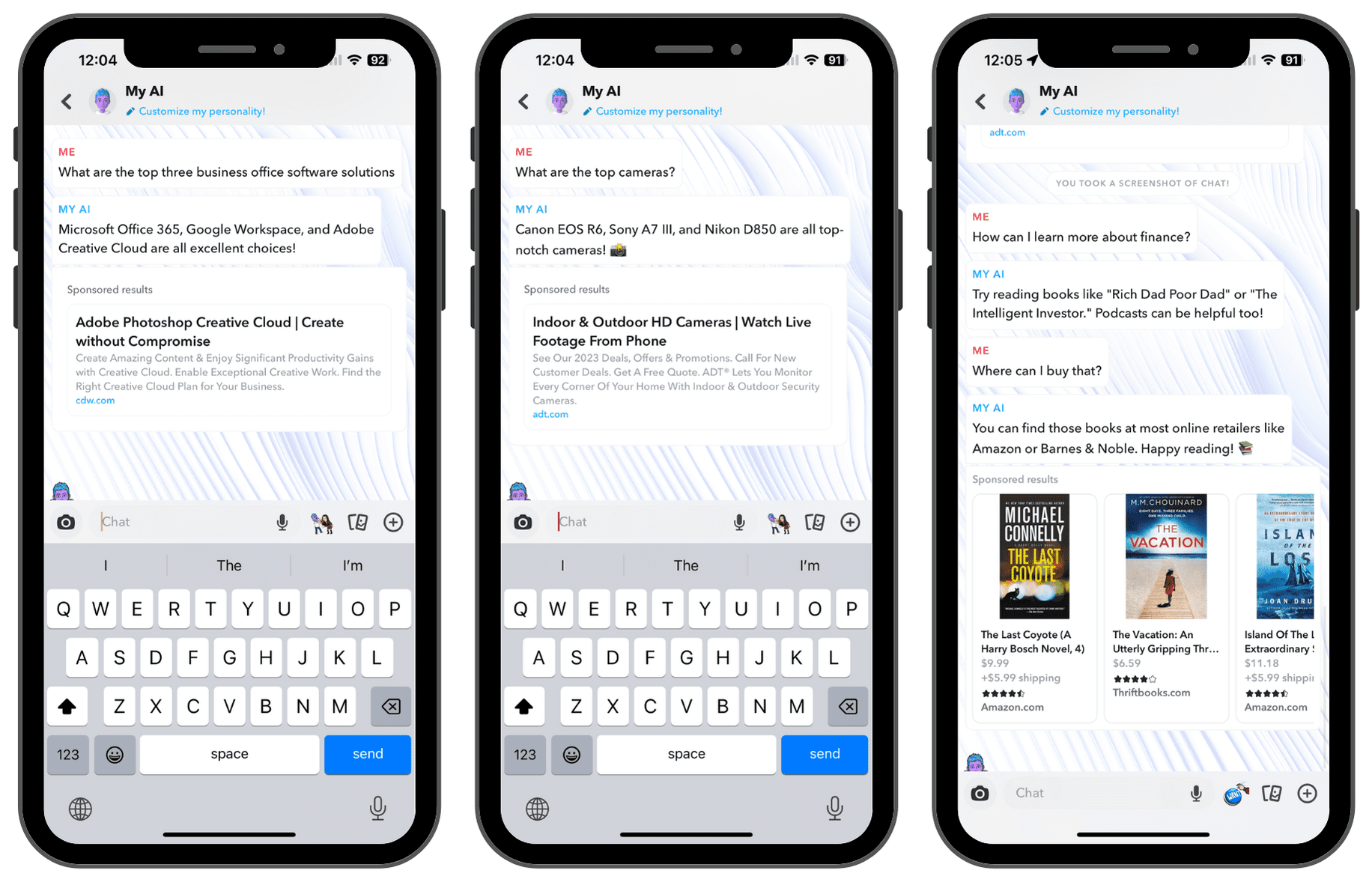
Microsoft Advertising and Snap have announced a pivotal partnership that positions both tech giants at the vanguard of advertising innovation.
Using Microsoft’s Chat Ads API, Snap aims to serve sponsored links in Snapchat’s My AI chatbot, augmenting a dynamic user experience.
Snapchat boasts an impressive reach, with more than 750 million active users per month who send billions of messages daily.
Microsoft, likewise, has been making strides with its recent advancements in AI technology, notably through Bing and asset recommendations for Responsive Search Ads.
This partnership will facilitate Sponsored Links in Snapchat’s My AI, one of the largest consumer chatbots, interacting with over 150 million people.
The following shows sample ads from CDW, ADT, and Amazon, along with the conversations that led My AI to serve sponsored links powered by the Ads for Chat API.






For advertisers, this collaboration offers a significant ROI potential.
Using Microsoft’s generative AI technology, brands can engage deeply with Snapchat’s youthful, mobile-first audience.
Furthermore, Microsoft’s focus on mobile improvements resonates well with Snapchat’s user base, making the partnership a strategic move for both companies.
Advertisers can view the impact of Snap traffic in the Microsoft Advertising publisher report, found under the “Microsoft sites and select traffic” category.
During the testing phase, advertisers saw an increase of over 15% in mobile impressions from this category while maintaining or improving cost per acquisition.
Microsoft and Snap vow to remain attuned to advertiser feedback as they refine their chat ad offerings.
This initiative is not just a one-off; it marks a strategic milestone in the continued growth of generative AI in advertising.
Microsoft encourages inaugural partners using the Chat Ads API to provide feedback through its advertising feedback portal and social media.
In addition to its current partners, Snap and Axel Springer, Microsoft has noted plans to expand the new advertising option to more partners soon.
It encourages interested companies to fill out a partnership application for help with “algorithmic organic results and ads monetization or ads monetization only.”
Featured image: ECO LENS/Shutterstock
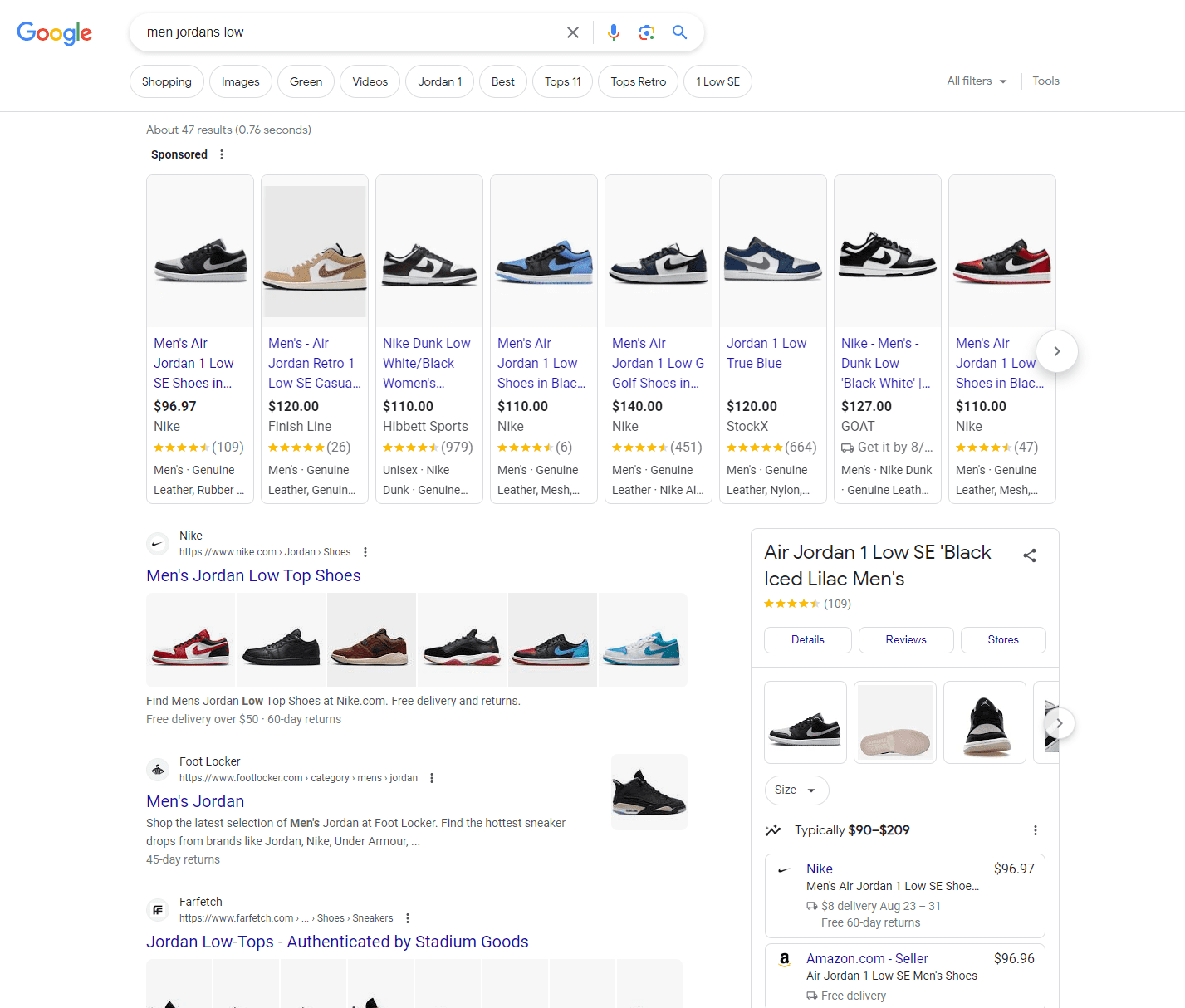
Search engine optimization (SEO) is an inherently competitive activity.
For every popular search term, there are countless websites vying for the top spot in Google’s rankings.
And since the top three placements in Google’s results pages receive a staggering 77% of all organic clicks, it’s easy to see why competition is so fierce.
One of the best ways to increase your organic search presence is to regularly seek out SEO competitive insights.
Studying what works well for your SEO rivals and identifying their weaknesses can help you finetune your own strategy for a greater competitive edge.
This post will teach you how to analyze your competitors’ SEO strategies so you can discover new opportunities to overtake them in the search results.
We’re all familiar with the well-known idiom “know your enemy.”
The idea is that understanding your opponent’s strengths, weaknesses, and tactics can help you find ways to navigate the competitive landscape more effectively.
Organic search is no different. You can learn a lot about how to achieve your SEO goals by analyzing high-ranking competitors.
After all, if a competitor is consistently outranking you, they must be doing something right. And once you figure out what that “something” is, you can apply it to your own SEO strategy.
Likewise, if you discover that a competitor’s approach falls short in some way, you can capitalize on the opportunity to do it better.
And the best news? All it takes to find valuable SEO competitive insights is a little detective work.
Now let’s look at the main steps involved in extracting insights from your competitors’ search activities.
The first step is to identify your SEO competitors.
No doubt you already know who your traditional business rivals are, but remember these may differ from your actual search competitors. The internet is a big place, after all.
The simplest way to figure out who you’re competing against is to search Google for the type of terms you want to rank for and take note of the sites that consistently appear.
For example, suppose you wanted to rank for the term [men jordans low]. In that case, your SEO competitors would include Nike, Foot Locker, and Farfetch.






You should also check the competition for location-based searches if your business serves customers in a particular geographic area.
Let’s say you run a boxing gym in Nashville. Here’s what your local SEO competition looks like.
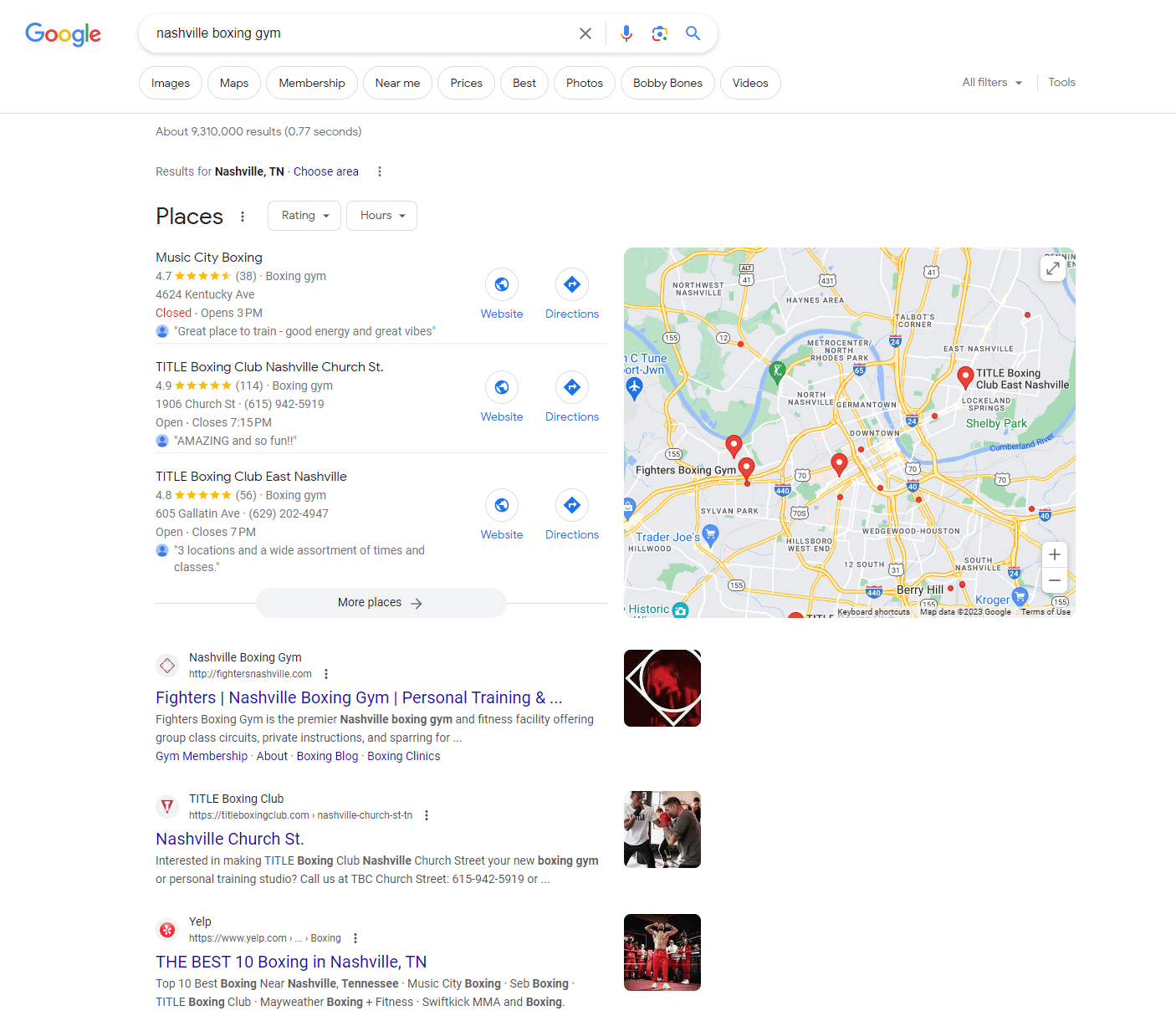





Bonus Tip: Instead of looking at individual keywords to see who is ranking, you can also use Ahrefs and navigate to Site Explorer > Organic Competitors. This shows competing websites that rank in the top 10 organic search results for the same keywords that your target gets the most traffic from.
See the example below:
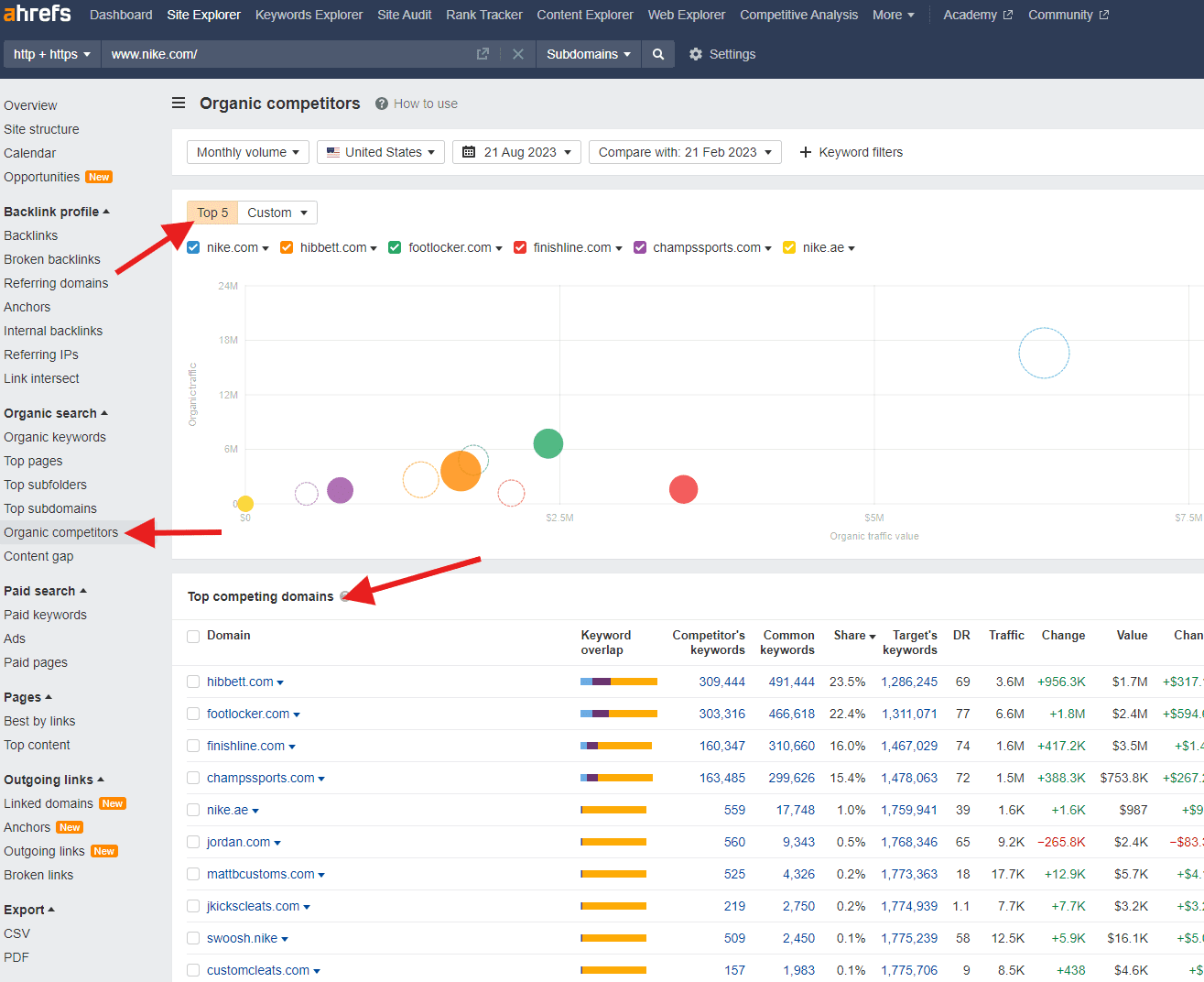





Now that you know who your competitors are, the next step is to build a full picture of the keywords they’re ranking for. This exercise will help you identify new terms that you should be targeting.
The most efficient way to approach competitor keyword research is to use a dedicated SEO competitor analysis tool, like Semrush or Ahrefs. Note that these tools require a paid subscription (although Semrush does offer a 14-day free trial).
To get a comprehensive list of a competitor’s keywords in Semrush, head to “Organic Research” and enter your competitor’s domain name.






In the dashboard, you’ll see a section labeled Top Keywords, which you can expand by clicking View all keywords.
Here’s an example from nike.com.
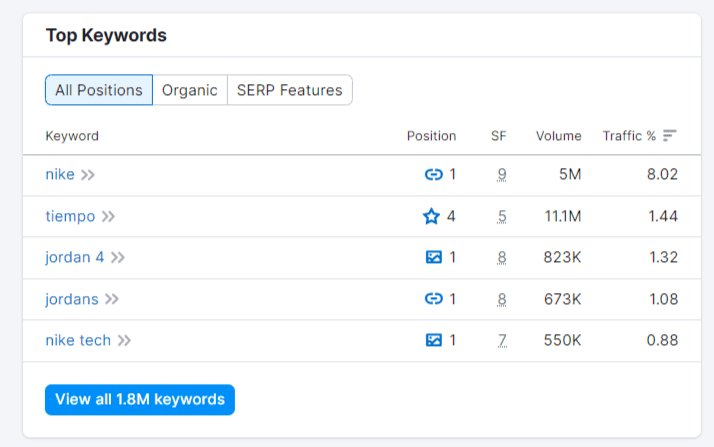





You can then export the keyword list into a spreadsheet and filter out any branded terms (for example, any terms containing the brand phrase “Nike”).
This will leave you with a full list of all the non-branded keywords your competitor ranks for, including monthly search volumes and a link to each ranking page.
Once you repeat the process for all your main competitors, you can compare the data with your own ranking keywords and identify any terms you don’t yet rank for.
Keep an eye out for any high-volume terms that only one or two competitors target. These will often be easier for you to rank for.
You should review each keyword individually and consider whether it’s appropriate for your business. If it’s a good fit, you should target it!
Knowing which keywords you should target is one thing. Knowing how to target them is another thing entirely.
This is why the next step is to examine the competitor content that performs well for your desired terms so you know what it takes to rank for them.
The first thing to consider for each keyword is the content type.
Is it presented as a long-form how-to guide? An infographic? A video?
And what about the depth and breadth of the content? Does it cover subtopics or only stick to the core subject area?
Remember, Google invests a lot of time and energy into serving users results that best match their search intent. For this reason, the top-ranking results are an excellent guide to how you should approach your own content.
Finally, you should study how successful competitors have optimized their on-page elements for the keyword in question.
Chances are, the keyword will appear in the URL, page title, H1 header tag, and throughout the body copy. Be sure to note the use of any keyword variations so you can incorporate them into your own content.
It’s impossible to overstate the importance of backlinks for SEO.
Not only do they send qualified referral traffic your way, but they also indicate to Google that your site is trustworthy and authoritative. The more high-quality links you get from other sites, the easier it is to rank.
Understanding which sites link to your high-ranking competitors will help you develop a roadmap for your own link-building strategy.
There are several tools you can use to conduct a competitor backlink analysis, including Ahrefs and Moz Link Explorer.
Once again, these tools require a paid subscription to access comprehensive datasets, but some also give you a free snapshot of the links pointing to your competitor sites.
For example, Ahrefs’ free backlink checker provides the top 100 backlinks for any domain, including the referring page, anchor, and target URL.
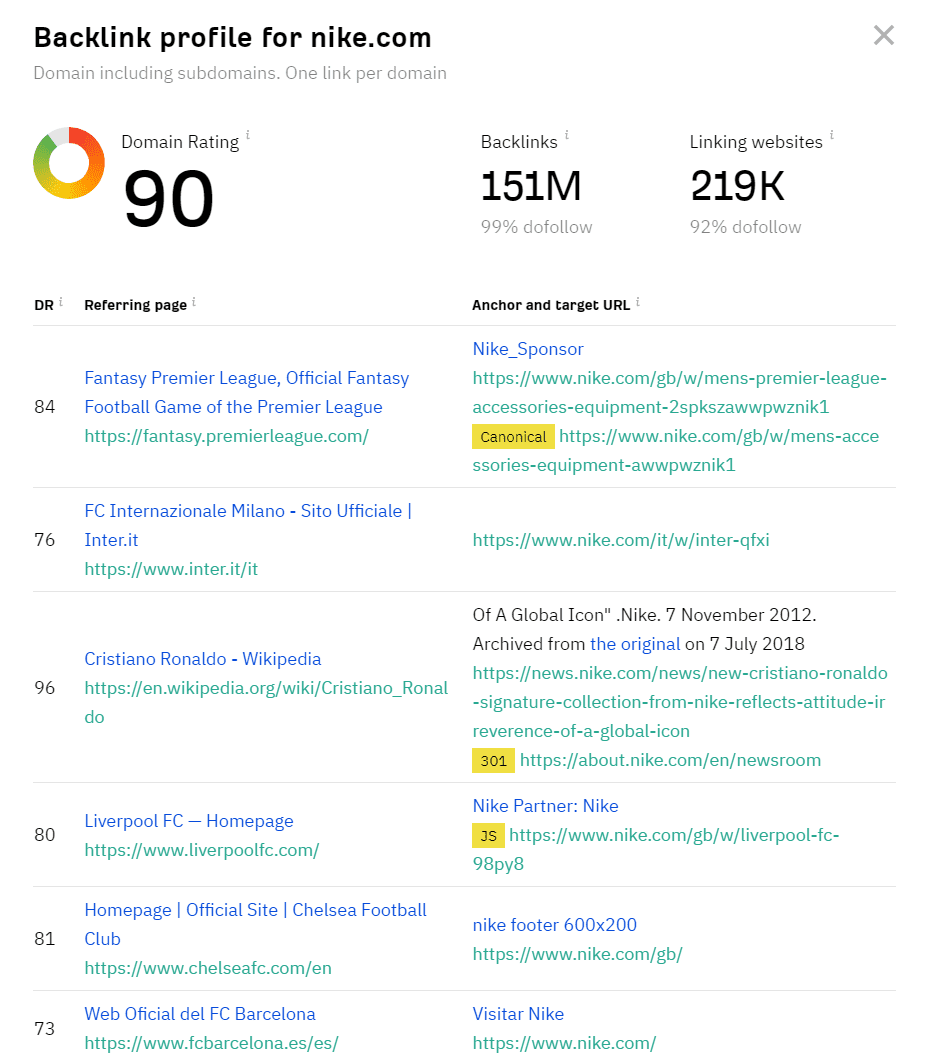





Once you’ve finished exporting your competitors’ backlink data, it’s time to work through the list and highlight any authoritative, niche-relevant domains that come up.
These sites will be your prime candidates for link-building outreach. Since they’ve already linked to your competitor’s content, they may well be prepared to link to yours.
For example, if one of your shortlisted websites links out to a broken page or an outdated piece of content – and you have a better, more up-to-date resource – you could reach out to the website owner or editor to suggest a replacement.
The next tip for uncovering SEO competitive insights is to assess how your high-performing competitors deliver a positive user experience to their visitors.
Remember that page experience is a signal used by Google to determine where your site should rank in its search results.
The most important UX performance metrics to consider are the so-called “Core Web Vitals,” which include page load speed and the interactivity and visual stability of on-page elements.
Put simply, the faster your site loads, and the more responsive it is to user inputs, the better the user experience will be.
You can compare your site’s user-friendliness with your competitors by entering their domain name into Google’s free PageSpeed Insights tool. Remember that your site should work just as well on mobile as it does on desktop devices.
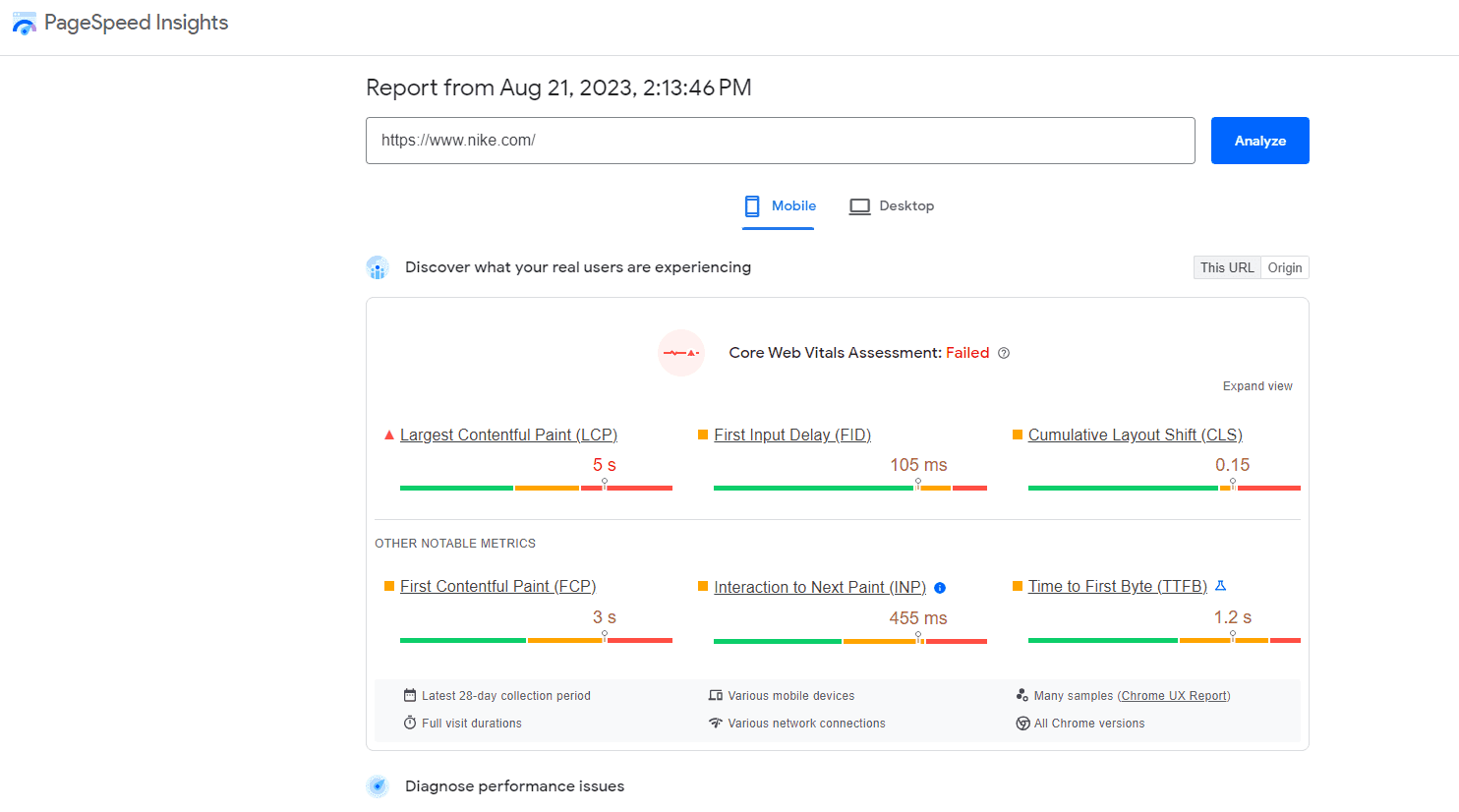





Site structure and navigability are also essential considerations for website usability.
If your site is organized confusingly and makes visitors click several times to find the page they want, you need to address the issue as a priority.
On the other hand, if your competitors outrank you even though their sites are also poorly structured, there’s a good chance that you’ll gain ground in the search results by tidying up your site.
Researching your competitors’ organic search strategies can be a shortcut to building a more effective SEO campaign.
Once you understand why other websites excel compared with yours, you can take steps to reverse-engineer their success by incorporating similar tactics on your own site.
By following the steps outlined above, you’ll be well on your way to developing a high-performing SEO strategy.
Now go out there and uncover some insights!
More resources:
Featured Image: tavan150/Shutterstock
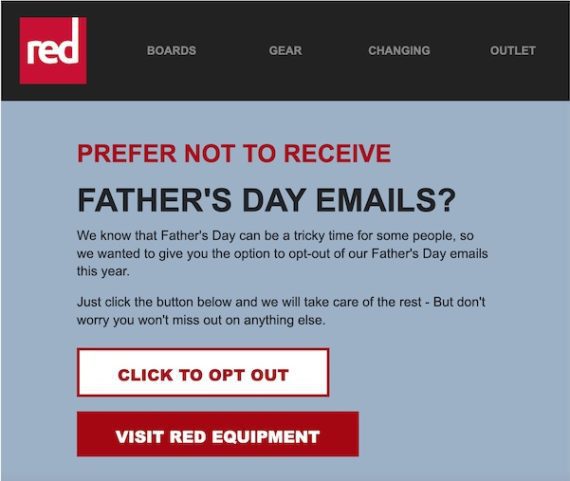
Email marketers know the challenge of in-box saturation, with modern consumers receiving dozens of daily promotions.
Giving recipients more control, especially around holidays, can help. Take Mother’s Day and Father’s Day as examples. Both have much sales potential but can pain customers experiencing bereavement or separation. Allowing them to opt out of those occasions reduces unsubscribes and builds trust, leading to more sales in the long term.
Here are three examples.
Red, a sporting goods merchant, allows subscribers to opt out of Father’s Day messages. It sends a dedicated email for that purpose. The message is clear, with a prominent “Click to Opt Out” button. However, the subject line — “Update your preferences” — is unclear and easily overlooked.
Red sends a dedicated email allowing subscribers to opt out of Father’s Day messages. Click image to enlarge.
The U.K. retailer Marks & Spencer allows subscribers to opt out of Mother’s Day and Father’s Day messages. The subject line — “Prefer not to hear about Mother’s Day?” — is direct and unambiguous. The body copy includes a deadline, setting expectations and mitigating questions and follow-ups.
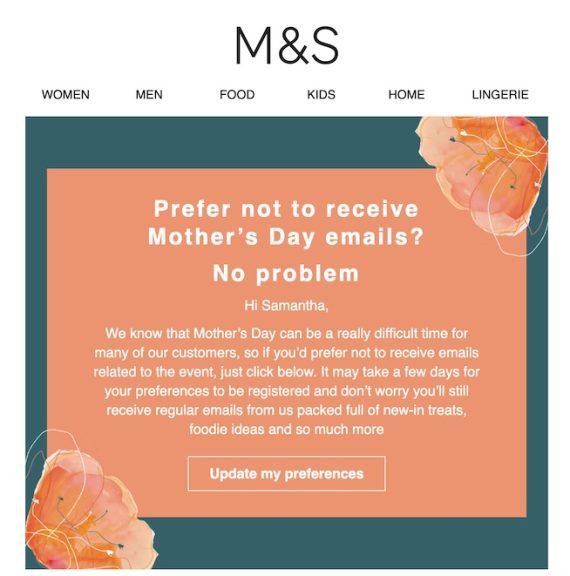


Marks & Spencer allows subscribers to opt out of Mother’s Day and Father’s Day messages. Click image to enlarge.
In 2019 online florist Bloom & Wild offered an email opt-out for Mother’s Day. The overwhelming response led the company to launch “The Thoughtful Marketing Movement,” now a community of 170 businesses.
Bloom & Wild’s opt-out emails are text only, styled as a personal message. The screen capture below reads:
Subject line: A sensitive occasion is coming up
Hello Sam,
In a few weeks’ time, we’re going to start sending emails about Father’s Day. If you’d rather not hear about it, that’s totally fine. You can let us know here.
Once you’ve opted out, we won’t send you anything related to this date. You’ll still get our other emails though, like normal.
And remember, if you ever want to update your contact preferences for a different sensitive occasion, you can do that at any time from your account.
Have a lovely day.
Lucy
Bloom & Wild’s head of retention addressed thoughtful marketing in a Medium post, describing the positive response from the media and customers, stating, “Lifetime value is higher for customers who opted out. In fact, in our most recent sample, opted-out customers had a lifetime value 1.7x that of non-opted-out customers.”
Merchants looking to implement email opt-outs should consider which occasions align with their audience. I’ve received opt-outs for Mother’s Day, Father’s Day, Grandparent’s Day, and Valentine’s Day. Religous-themed occasions and geo-focused holidays are prime opt-out candidates.
Send a dedicated email long before the occasion and ensure the subject line and body copy are clear. Remind recipients that opt-out is specific and does not affect other messages or their subsubscription.